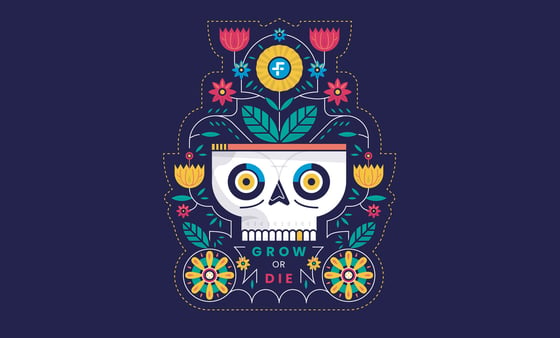


Not all growth is good growth - and why you need to grow smart




Growth is in our DNA; it’s one of our core values and it literally says it on the clothes we wear. But not all growth is good and bad growth can be toxic. This is our journey to ‘good growth’.
Since the outset of the agency (which honestly feels like a lifetime ago), we’ve tried to focus on growth. Out and out growth. It’s always been an obsession and it’s been one of our core values since day one.

But, not all growth is created equal.
As an agency, we’ve tended to focus on growing our client and retained revenue base. But with a bit of hindsight, maybe there was a smarter way,
So, that brings me to this blog. It’s an outline of our ‘grow better’ journey. Something I hope you’ll find useful whether you’re an agency like Six & Flow or running a business out of the agency landscape.
Standard disclaimer: we are not perfect at this. But we have worked hard at it over the last few years. We think we’ve made some headway and hopefully that might be useful to you too.
We still get loads of what is in here wrong and there’s probably things we’ve got right that I’ve forgotten about. But that’s fine. It gives me an excuse to update it and recycle the post in a few months time #EverGreenContent...
Saying “no” to clients.
We’re not the first company that says they say ‘no’ to the wrong sort of client. But to start with, that wasn’t always the case. When you’re in the scrappy start up mode, it can be very, very difficult to turn away from potential revenue. But, as you grow, you start to have a better understanding of who it is you can help, who you can work well in partnership with and where you just need to turn away.
From the beginning, we’ve tried to stay true to our original three-pronged approach to who makes a good client. We still use this with every single potential new client that comes through our door.
- We have to believe in the product or service the client offers
- We have to believe we can offer real value to the client
- The client can't be a dickhead
It can be much easier to spot the wrong type of client if you sell a product. If you sell cat biscuits and a dog owner walks in you have two choices; tell him your product is not right for him or convince him that the cat biscuits are so good, dogs will like them. The outcome of the first option is you don’t make a sale. The outcome of the second option is that you make a sale, gain a client and should now be braced for the coming review backlash… that same client is now spending his evening cleaning up dog sick (unpleasant for him) and taking to social media telling everyone about what happened (even more unpleasant for you).
If you sell a service it can be harder to spot an unsuitable client. Services can be adapted, they can be moulded to suit. But it’s not just about the functionality of the service - it’s about your suitability to deliver those services for that client. Do you have the expertise in their market? Do you understand their needs and challenges?
But, just having a three-point checklist for a client isn’t quite enough - it doesn’t qualify the client-agency fit enough to really understand if you’re going to be entering a good, valuable long term partnership.
That’s where our client fit matrix comes into play. It’s a framework and scoring matrix that allows our sales team to very quickly build out an understanding of how good a fit we’re going to be for the prospect. It covers everything from industry to turnover to team structure and a whole bunch in between.
We don’t say no to clients because we don’t want new clients. Nor do we say no because we’re trying to portray scarcity or exclusivity. We say no because we want an agency that people love to work for and that does a great job for our clients. Having the right fit between agency, team and clients is the only way to drive that.
And you definitely can’t have that if you sell cat biscuits to dogs.
You need to know what ‘better’ is.
The idea of growing ‘better’ or ‘smarter’ is pie in the sky if you don’t know what better looks like. Does ‘smarter’ equal ‘happier’? Is there a monetary value to it? Does ‘better’ equal ‘higher margins’?
For us, better means ‘team first’, because we believe ‘team first’ makes things better not only for us but for our clients too. Your own version of ‘better’ doesn’t need to be the same, but you do need to know what it is. Like any target, you will not hit it if you don’t know anything about it.
Where ‘grow better’ is not quite going right for people, this is the thing I feel is most often wrong. The Netflix culture code - co-authored by Patty McCord is a great example of aligning and outlining team culture. HubSpot themselves have a fairly famous culture code Slideshare that’s been viewed almost 5 million times. For HubSpot, if that culture exists, then better growth will follow. Finding your own version of this is a big key.
Everyone needs to know what growing smart is. And by ‘everyone’, I mean sales and marketing.
It’s important that your whole team knows what growing smarter means to you as an organisation. It is doubly important that your wonderful marketers and ultra-driven sales people know what growing better means inside out.
In our case the very notion of growing better involves the team and we still needed to address this explicitly.
Marketers want to show they are good marketers by generating a lot of leads. Sales people want to show how good they are at sales by closing a lot of sales.
The mentality shift that has to happen here is that each group knows what good growth means when it comes to leads and closed sales. There is nothing more dispiriting to a marketer than telling them the lead they have presented you with is not good. This situation is even worse with a sales person. Imagine sacking a client immediately after sales have closed them. Not a great feeling for anyone.
If sales and marketing know what growing smarter means they can self-police their approach. They will recognise a lead that does not contribute to smart growth early and weed it out.
More importantly, fostering an understanding of what shared targets or goals are between the sales and marketing team, in line with what the right growth looks like is critical. Every client we work with, we highlight that they must encourage a ‘shared number’
Growing smart is still growing.
Now, I don’t know about you, but the idea of turning business down sticks in the throat a little bit. It’s the antithesis of most entrepreneurial drivers. Often, in the early years of business growth, while you’re finding your feet, you chase ALL business - it’s a game of survival with an awful lot of statistics stacked up against you.
This is an under-discussed part of this whole piece. Growing smarter has sometimes felt like a list of ‘don’ts’.
Don’t work with the wrong client. Don’t work with people who don’t suit you. Don’t pursue unsustainable growth. And yes… one of our pillar principles, ‘don’t work with dickheads’...
When you start looking at this properly it can feel like you are being told not to grow. I can pinpoint the moment when it will feel like this, if it doesn't already: when you sit down with a salesperson and tell them not to pursue a prospect. Or, even better, when your sales team is coming to you and saying they don’t think the prospect is a good fit for your business. In what sort of world did you imagine you’d be discussing not selling with your sales team..?
It’s important to remember that it’s OK to grow and that as part of growing smart, you will make mistakes and grow badly. Shit happens and it’s how we learn from it and adapt that’s key. Don’t be afraid to look for opportunities and grab them when they arise.
In the last three years we’ve become a Diamond HubSpot partner, reported great growth in revenue figures and signed significant partnerships with key growth tools like Drift and Vidyard. We’ve recently announced that we’re growing further by opening a London office, which is a big step. But it still feels like growing better. And it is definitely still growth.
Don’t stop being afraid to take chances, after all, that’s a big part of what make running a business fun.







